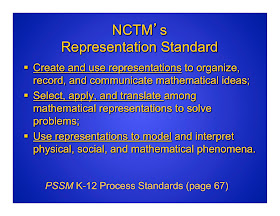A few years ago, John Golden and I co-taught Teaching and Learning Middle Grades Mathematics. During the first unit on Doing Mathematics, we noticed that the preservice teachers were struggling to unpack how they used various representations to support their problem solving. We wondered what would happen if we limited the representations they could use while looking for a pattern in a sequence. That is how this workshop came to be.
Doing Math Workshop (Representations)
Schema Activation: What representations did Carl use?
We have been talking about writing Metacognitive Memoirs as a way to make our thinking visible as we solve problems in mathematics. Here is an example from Carl that we found on the internet. Please identify all the representations he uses in his write-up.
Focus: Representation Standard
This comes from the NCTM's Principles and Standards for School Mathematics:
In
order to make our think alouds explicit, as it relates to this Process Standard, we need to highlight where we are using these algebraic representations:
- real; pictorial; verbal; written; numeric; tabular; graphical; and symbolic (recursive and explicit relationships)
These are the images we use to understand and communicate mathematics. This is analogous to mental images used to enhance reading by immersing the learner in the subject.
Activity: Limiting Representations for Thinking
The students are asked to avoid using any of the representations not explicitly identified on the worksheet. In this first case, they are limited to using only pictorial and symbolic representations. After a couple of minutes, I allow them to use verbal so that they can share with one another their efforts thus far.
The next worksheet limits the students to using verbal, written, and symbolic representations. This semester, one of the students expressed a great deal of discomfort with the fact they she was not going to be able to use the representations with which she was most comfortable. We talked briefly about how this might mirror how students who struggle could feel regarding the representations we expect them to use in our classes. Again, I added another representation, this time manipulatives (real), after a few minutes.
On the last worksheet, the students are limited to using tabular and symbolic representations. One student said she was relieved to be back in familiar territory. When I offered to add another representation of their choosing, they asked for verbal so that they could talk over the problems. It turned out that tables were not enough to help them feel confident in their answers.
Reflection: Journal Jot
How did limiting the representations you could use
affect your thinking?







